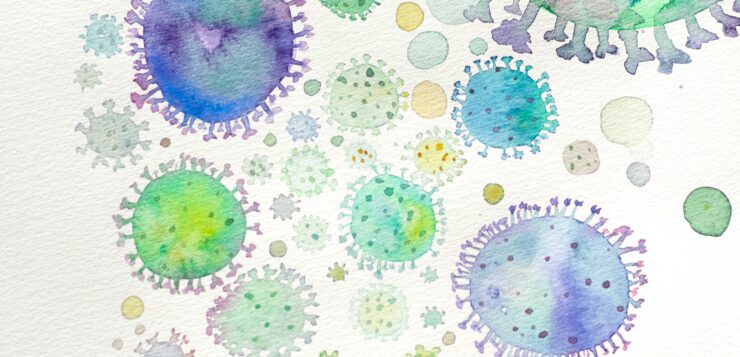The effects of the most recent virus to sweep through the UK’s population are still being felt, but already a different one is making headlines. Monkeypox has spread globally since its initial outbreak in the spring with cases now detected in 50 countries, including nearly 800 in the UK, the most of any European nation. Whilst the numbers themselves are not exactly explosive, this outbreak has scientists and public health officials doing a fair bit of head-scratching, so you might be asking what’s going on and what might happen next?
To try and answer that, it’s first worth taking a short dip into virology corner, somewhere that many of us have spent more time than planned over the last couple of years. Like cold, flu and Covid-causing viruses, Monkeypox is also a virus, but that’s pretty much where the similarities end and its closest relative is the Variola virus that causes Smallpox, a more severe disease that was eradicated in 1980. It’s a common disease in Western and Central Africa and initially causes generic virus symptoms (fever, headache, muscle aches etc), before breaking out in pus-filled blisters that eventually scab over and fall off. It’s name is actually misleading – it was first identified in 1958 in monkeys, but is most likely to be spread by rodents.
Basics and irritating misnomer out of the way, what makes this particular outbreak interesting?
Firstly, it’s weird. Cases of Monkeypox in western countries are unusual in themselves and like this outbreak, are almost always linked with travel to Africa. Monkeypox is pretty clumsy when it comes to spreading between humans and needs close contact, such as hugging, sexual intercourse or touching the bedsheets of someone with Monkeypox scabs, so these outbreaks tend to spread between close friends and family members before fizzling out. This outbreak hasn’t stopped yet, which means one of two things, either the virus has changed to become more transmissible, or has just found itself in the right place at the right time to spread more. The former seems unlikely – genetic analysis of virus samples from UK patients has found little difference from the strain circulating in West Africa, and this family of viruses doesn’t tend to mutate very much – in around 170 years of vaccination programs against smallpox, it still didn’t change enough to wriggle away from our efforts to protect against it.
The longest chain of transmission previously documented for a Western Monkeypox outbreak is 6 people, so the latter option would be unusual, but it isn’t impossible. That may be thanks to another piece of terminology that we’ve heard of before – the super-spreader event – where one infected person is in close contact with many others at say, a party or festival. Those people catch the disease, take it home with them, sometimes over long distances in our increasingly globalised society, and then give it to their own close contacts. This could explain how the disease has reached a number of countries where Monkeypox isn’t usually found in such a short space of time, but as yet, no super-spreader event has been identified. In fact the number of cases identified so far and their geographical spread suggests that transmission might have been rumbling along in the background for longer than we think. Several factors could be helping Monkeypox spread from person-to-person without major help from super-spreading events. One is that we haven’t been giving out Smallpox vaccines, which also provide some protection against Monkeypox, for the last 50 years, and so there is now a much larger number of susceptible people than for previous outbreaks. Another is that western countries simply aren’t used to dealing with Monkeypox. That means we don’t normally bother looking for it and our systems of tracking down and testing suspected cases have needed some time to really hit their stride. Finally, there’s the unusual feature of this outbreak affecting large numbers of younger gay and bisexual men, a population for whom stigma has typically made accessing healthcare more difficult. These reasons, perhaps combined with a particularly lucky chain of transmission, may have combined to form a perfect storm of transmission allowing Monkeypox to spread beyond its normal limits without the need for genetic changes or super-spreading.
Seeing as this outbreak has burst beyond those normal limits, how dangerous actually is it?
Firstly, it’s important to say that this is not going to be the next Covid. Whilst steady, transmission doesn’t seem to be taking off and even if it did, we already have vaccines and treatments for Monkeypox that we know are effective and are now rolling out to vulnerable groups. Monkeypox is also a mild disease for most people, with only one death and few hospital admissions connected to this outbreak, and death rates from countries where Monkeypox is normally found are likely to be inflated by hospitals being poorly-resourced and documenting only more severe cases. Crucially, this seems to be a virus that is only infectious when someone has symptoms, unlike Covid, which had the unfortunate feature of being most infectious when people were still going about their business unawares.
So this isn’t a disease that you’re going to catch by sitting next to the wrong person on the U1A, and even if it was, it’s unlikely it’ll make you that sick. That said, there’s still plenty of reasons to stop it from spreading. Monkeypox can still be severe and even fatal in young children, as well as those with weakened immune systems, and we want to prevent it from taking hold in these groups, particularly as like all bugs, the virus can spread more easily in nurseries and day-cares. There’s also the slim, but possible risk that the virus could jump back into a local animal population and form a reservoir there, as in endemic countries. This has prompted the bizarre, but entirely justified advice to not touch your hamster if you have a funky rash. This being the NHS, there’s also the nation’s finances to consider and cutting out cases before they need hospital care or become common enough to warrant a mass vaccination campaign is important to do – as far as cost-efficacy is concerned, prevention is better than the cure.
This isn’t a crisis, but it’s not something to ignore either.




